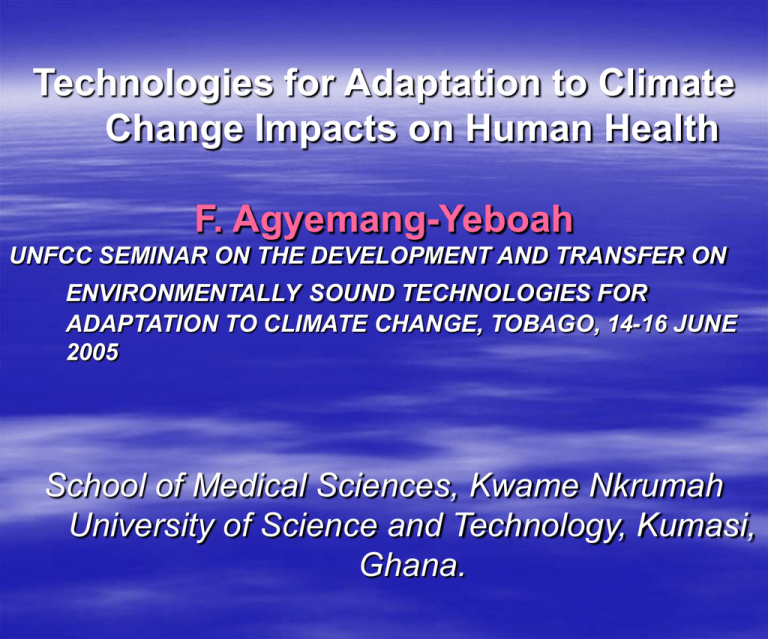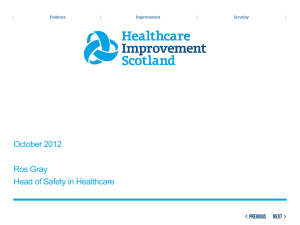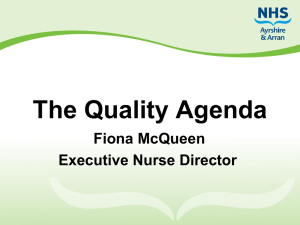Technologies for adaptation to climate change impacts on human
advertisement

Technologies for Adaptation to Climate Change Impacts on Human Health F. Agyemang-Yeboah UNFCC SEMINAR ON THE DEVELOPMENT AND TRANSFER ON ENVIRONMENTALLY SOUND TECHNOLOGIES FOR ADAPTATION TO CLIMATE CHANGE, TOBAGO, 14-16 JUNE 2005 School of Medical Sciences, Kwame Nkrumah University of Science and Technology, Kumasi, Ghana. Summary of Presentation 1. Potential Climate Change Impacts on Human Health-An illustrative model 2. The Ghanaian Case Study 3. Identification of technologies from the Ghanaian perspective 4. Other options of Adaptation technologies 5. The decision making process 6. Conclusion INTRODUCTION AND BACKGROUND Potential Impacts of Climate Change on Human Health It is now established that global climate change would affect human health via pathways either directly or indirectly at different time rate. Climate change act via less direct mechanism to affect the ecosystem and therefore the transmission of many diseases. It also affects food security. The distribution and abundance of vector organisms (carriers) and intermediate hosts are affected by both physical (temp. humidity. rainfall etc.) and biological factors (vegetation, host species, competitors, predators etc.) in the ecosystem POOR RAINS Inadequate in volume and distribution Poor grass Poor Harvest People Underfed (Malnutrition) Poverty Animal death Less meat, less milk Animals underfed Overgrazing where grass is good Overgrazing, trees cut down for fuel Grass /vegetation cover lost LAND DEGRADATION TYPICAL CASES FROM GHANA Mean air temperature scenario – seasonal pattern Mean air temperature baseline 33 32.1 32.1 32.1 Mean air temperature 2020 32 31.4 Mean air temperature2050 31 30.1 30.6 30 Mean air temperature 30 29.9 28.6 28.6 28.5 28.2 27.9 27 28.2 27.6 27.2 27.6 27.1 27.2 26.9 26.6 27 26.5 26.6 26.7 26.5 26.3 26.6 25.8 26 25.4 25.8 25.3 25 26.1 26 25.3 24.9 24 Jan 28.1 27.7 27.9 28.6 28.5 28.4 28 30.1 29.4 29.6 29.2 29 30.5 Mean air temperature2080 Feb Mar Apr May Jun Jul 24.8 Aug Sep Oct Nov Dec Distribution of the number of malaria cases and maximum air temperature 90000 38.0 Number of Outpatient Malaria Cases 70000 60000 Feb-02 35.70C Feb-01 35.50C Mar-00 34.90C 36.0 Mar-03 34.90C Jan-04 33.90C Feb-99 33.40C 34.0 50000 32.0 40000 30000 30.0 20000 Sep-99 28.7 10000 Aug-00 28.2 Aug-01 27.6 Aug-02 28.0 Aug-03 28.4 28.0 Aug-04 27.7 0 26.0 Jan- Apr- Jul- Oct- Jan- Apr- Jul- Oct- Jan- Apr- Jul- Oct- Jan- Apr- Jul- Oct- Jan- Apr- Jul- Oct- Jan- Apr- Jul- Oct99 99 99 99 00 00 00 00 01 01 01 01 02 02 02 02 03 03 03 03 04 04 04 04 Time (1999 - 2004) Number of malaria cases Maximum Temperature High maximum air temperature values corresponds to low number of malaria cases and vice versa. Maximum Temperature (C) 80000 DISTRIBUTION OF MALARIA CASES AND MEAN RELATIVE HUMIDITY 75000 Jun-99 82% 65000 Apr-99 79% 55000 Jun-00 84.5% 15000 Oct-03 68043 85 80 75 Dec-00 72.5% Dec-00 34866 Apr-99 30730 Aug-01 46039 70 Sep-99 37898 35000 25000 Jun-03 82.5% Jun-00 56000 Jun-99 48000 45000 84.5% Aug. 02 84.5 90 Feb-02 41979 Jul-01 40505 Feb-02 63.5% Mar-03, 67.5 Feb-03 39700 (72%) Feb-00 55% 18717 Feb.00 65 60 55 5000 50 YEAR (1999 - 2003) MALARIA CASES MEAN RELATIVE HUMIDITY •Generally, increasing mean relative humidity corresponds to increasing incidence of malaria, whilst decreasing mean relative humidity corresponds to decreasing incidence of malaria. MEAN RELATIVE HUMIDITY (%) Sep-99 84.9% Aug-02 80300 Aug-01 Jul-01 86% Ja n M -99 ar M -9 ay 9 Ju -99 Se l-9 9 Nop-9 9 Ja v-99 n M -00 ar M -0 ay 0 Ju -00 Se l-0 0 Nop-0 0 Ja v-00 n M -01 ar M -0 ay 1 Ju -01 Se l-0 1 Nop-0 1 Ja v-01 n M -02 ar M -0 ay 2 Ju -02 Se l-0 2 Nop-0 2 Ja v-02 n M -03 ar M -0 ay 3 Ju -03 Se l-0 3 Nop-0 3 v03 OUTPATIENT MORBIDITY MALARIA CASES 85000 90000 400 80000 350 70000 300 60000 250 50000 200 40000 150 30000 100 20000 50 10000 0 0 Jan- Apr- Jul- Oct- Jan- Apr- Jul- Oct- Jan- Apr- Jul- Oct- Jan- Apr- Jul- Oct- Jan- Apr- Jul- Oct- Jan- Apr- Jul- Oct99 99 99 99 00 00 00 00 01 01 01 01 02 02 02 02 03 03 03 03 04 04 04 04 Time (1999 - 2004) Number of malaria cases Rainfall Amount Rainfall amount (mm) Number of Outpatient Malaria Cases Distribution of the number of malaria cases and rainfall amount Comments Baseline study shows that under the present climatic conditions malaria is perennial. Mean air temperature ranges from mean air temperatures 24.8ºC to 27.9ºC for Ashanti Region The maximum number of malaria cases occurs in June at mean air temperature of 25.8ºC. Low number of malaria cases occurs in February , March and April where mean air temperature ranges from 27.6ºC in April , 27.9ºC in both February and March respectively. Distribution of Meningitis cases and maximum air temperature 45 38 Number of meningitis cases 35 Mar-99 33.30C Jan-03 390C 36 Jan-03 33.1 Jan-04 33.90C 34 30 32 25 20 Mar-99 17 15 Mar-00 18 30 Feb-01 15 28 Feb-02 7 10 Jan-04 7 26 24 5 0 22 Jan- Apr- Jul- Oct- Jan- Apr- Jul- Oct- Jan- Apr- Jul- Oct- Jan- Apr- Jul- Oct- Jan- Apr- Jul- Oct- Jan- Apr- Jul- Oct99 99 99 99 00 00 00 00 01 01 01 01 02 02 02 02 03 03 03 03 04 04 04 04 Time (1999 - 2004) Meningitis Cases Maximum air temperature Periods of high meningitis cases coincide with periods of high maximum air temperature Maximum Air temperature Mar-00 0 34.9 C 40 Feb-02 35.70C Feb-01 35.50C Distribution of diarrhoea cases and rainfall amount 9000 400 8000 350 300 6000 250 5000 200 4000 150 3000 Rainfall amount(mm) Number of Diarrheal Cases 7000 100 2000 50 1000 0 0 Jan- Jun- Nov- Apr- Sep- Feb- Jul-01 Dec- May- Oct- Mar- Aug- Jan- Jun- Nov99 99 99 00 00 01 01 02 02 03 03 04 04 04 Time(1999 - 2004) Diarrhoea Cases Rainfall amount High number of diarrhoea cases corresponds to periods of high rainfall amount and vice versa Direct Cost 210, 680 21, 500 4 529 620 000 Malaria Cost of malaria treatment – 2003 figures Total cost = Direct Cost + Indirect Cost Direct Cost = Costs of Drugs + OPD fees + Laboratory fees etc. Indirect Cost = Opportunity Cost of Labour for affected person and caring parent Total Cost for Children Total Cost for Children = Direct Cost + Indirect Cost Direct Cost = 210, 680 × ¢21500 = ¢4, 529, 620, 000.00 Indirect Cost = 210680 × ¢9600× 7 = ¢ 14, 157, 696, 000.00 Total for Children = ¢ 18, 687, 316, 000.00 Total Cost of Adults Total Cost for Adults (Direct + Indirect) Direct Costs = 353608 × ¢23,000 = ¢ 8132984000.00 Indirect Cost = 353608 ×¢9,600×7 = ¢ 23762457600 Total Cost for Adults = ¢ 31, 895, 441, 600.00 Total Cost Burden Total Cost Burden for Adults and Children in the year 2003 Total for Children + Total for Adults = ¢18, 687, 316, 000.00 + ¢31, 895, 441, 600.00 = ¢50, 582, 757, 600.00 (1US$~¢8,000 at 2003 which is approximately US$6,000,000/year) NB. Only two regions of Ghana. Summary of socioeconomic impacts Reduced income of affected individuals due to loss of productivity Increased expenditure of affected families Increased insecurity of employment (low skilled workers and casuals) Diminished quality of life Social disruption Reduction in Gross Domestic Product Increased cost of Health Delivery at the National Level Population Vulnerability and Adaptive Response It should however be mentioned that human populations as with individuals, vary in their vulnerability to certain health outcomes. This will thus affect not only the type but the choice of adaptive strategies to offset those effects. HEALTH ADAPTION STRATEGIES FROM THE GHANAIAN PESPECTIVE Two main strategies can be identified 1. PREVENTIVE STRATEGY( Primary, Secondary and Tertiary) 2. CURATIVE STRATEGIES (Diagnosis, Management and Monitoring) All technologies for adaptation (Ghana’s perspective) to combat the effect of climate change/variability on health will be discussed along this line. ADAPTATION OPTIONS NB. 1-3….PREVENTIVE ADAPTATIONS 4……CURATIVE ADATATIONS 1. PRIMARY PREVENTION: Any intervention implemented before there is evidence of disease or injury (e.g. avoiding hazardous exposure to asbestos, pollen, using insecticide-impregnated mosquito nets etc.) 2. SECONDARY PREVENTION: Any intervention implemented after disease has begun but before symptoms show (e.g. early detection or screening for say cholera) and subsequent treatment to avert full progression to disease. Enhancing monitoring and surveillance, improving disaster response and recovery and strengthening the public health system. 3. TERTIARY PREVENTION: Any intervention to minimize the adverse effects of an existing disease and injury (e.g. better treatment of heat stroke, improved diagnosis of vector-borne disease. MANAGEMENT – Any intervention taken to treat or manage existing diseases or injury (drug prescription and compliance) 4. HEALTH ADAPTATION STRATEGIES EXAMPLES FROM THE GHANAIAN PESPECTIVE DISEASE ADAPTATION TECHNOLOGY TYPE OF ADAPTATION LIMITATION/ COMMENT MALARIA DEVELOPMENT OF VACCINES, HERBAL PREPARATIONS Introduction of Predators to reduce vector population PREVENTIVE LACK OF RESOURCES INADQUATE FACILITIES SKILLED PERSONNEL MALARIA INSECTICIDEMPREGNETED NETS POCT, COMBINED THERAPY PREVENTIVE CURATIVE COST, INEFFICIENT HEALTH CARE DELIVERY SYSTEM CSM NEW ARCHITECTURAL HOUSE DESIGNS, EARLY VACCINATION, MOBILE CLINICS, Health Education PREVENTIVE CURATIVE COST CHOLERA BOLE-HOLE DRILLS, ACTIVATED CHARCOAL DOMESTIC FILTERATION SYSTEMS. POINT OF CARE TESTING (POCT) PREVENTIVE COST ALL DISEASE ALL DISEASES COMPUTER INFO. SYS. Telemedicine PREVENTIVE CURATIVE COST, LACK OF SKILLED PERSONNEL CURATIVE ETHICAL ISSUES OTHER SPECIFIC ADAPTION TECHNOLOGY OPTIONS Heat-related illness Design buildings to be more heat resistant (insulation, air flow, air-conditioning) Planting trees to reduce urban heat effect Creating public education campaigns to offset risk of heat wave Establishing new weather watch/warning systems that focus on health related adverse conditions Agricultural Stresses Production of climate- resistant seeds, plants, high yielding varieties eg. “Obaatanpa” maize- Genetically modified grains? (ethical issues) Promoting land reform and management systems that favour environmentally sound land usage Reducing the proportion of monocultural farming practices to increase yield and also for better resistance to pests. OTHERS- ELISA(Diagnostics), enzymes for biodegrading waste, Affrostestation, Bushes fires, bio-fuel to reduce air pollution APPLICATION TECHNIQUE/ TECHNOLOGY INDICATOR LIMITATION/ RECOMMENTATION Disease Surveillance Simple Mapping Studies GIS and Remote Sensing Mobile Clinics, POCT Disease Incidence, Prevalence May not provide quantitative estimate may lack compatibility Disease Monitoring GIS and Remote Sensing Telemedicine (satellite remote sensing) Disease Incidence, Prevalence May not provide quantitative estimate may lack compatibility/Cost Demographic Data/ Climate Prediction Simple Mapping Studies GIS and Remote Sensing Computer Information and Reporting Systems Disease Incidence, Prevalence Lack of trained and skilled personnel Weather extremes and Sea-level rise Engineering measures- sea walls Flash Flood , residential placement Maintenance of disasters, reduced erosion Inability to provide sufficient resources for engineering options Vector-borne disease Water-borne disease Installation of window screens, Vaccination, public education, promotion of pyrethroid impregnated nets, water filteration Disease Incidence, Prevalence Inability to develop pesticide and or drug resistance products Disease Control/Prevention Public Health Education, Releae of sterilized male insects to reduce reproductive capacity Disease Incidence, Prevalence Insufficient resources THE DECISION MAKING FRAMEWORK FOR ADOPTING A TECHNOLOGY-Key Questions (Monitoring and Evaluation) 1. What are the main drivers behind the decision? Is it mainly about adapting to future climate? If not, could climate change be important? Is it most appropriate to meet local needs? 2. What are the criteria for recognizing a successful outcome? What are the legislative requirements or constraints? What are the rules for making the decision? -risk averse or focused on maximizing benefit or minimizing cost 3. What is the lifetime of your decision? What climate variables could be most important? How could climate change affect your ability to meet your objectives? 4. What range of technology options should be considered? High Tech, Medium Tech or Low Tech? 5. How do these options rate against your criteria? Could particular options make it difficult for others to manage climate change? 6. Is there a clear preferred option? 7. Did the decision deliver the expected benefit or not? 1 1 8 7 Identify problem and objectives Monitor 2 3 Implement decision No 4 Identify options Yes Problems defined correctly? 6 YES Criteria met? Establish decision making criteria Assess risk 5 Appraise options Conclusion Effective technological adaptation and transfer will require individuals skilled at recognizing, reporting and responding to health threats associated with climate change. Building capacity is therefore an essential step in preparing adaptation strategies. Education, awareness creation and the creation of legal frameworks, institution and an environment that enables people to take well-informed, long-term sustainable decision are all needed. Building adaptive capacity in public health will also require strong and determined vision of appropriate healthcare delivery systems. It must be stressed adapting to climate change will require more than financial and technology, human resource and knowledge are essential as well as institutions that are committed to face the health challenges associated with climate change. END THANK YOU !





